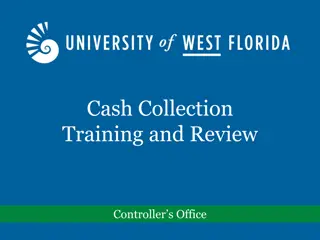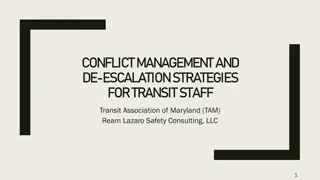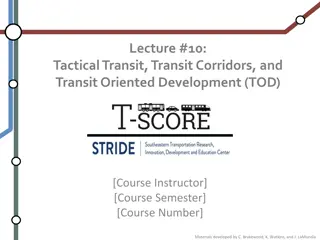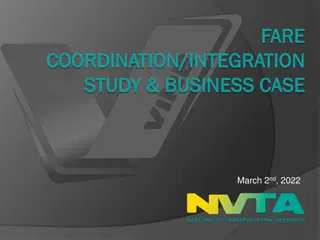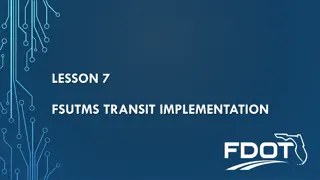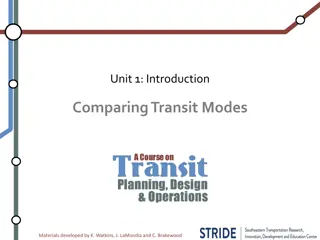Cash-in-transit (CIT) Security Guidelines
The document delves into legal regulations, the CIT cycle, risk assessment, execution, transportation equipment, and more. It covers EU regulations regarding cross-border transport of euro cash, national regulations, staff training requirements, and CIT security procedures. Explore the complexity of CIT services and the stringent rules governing CIT operations.
Download Presentation

Please find below an Image/Link to download the presentation.
The content on the website is provided AS IS for your information and personal use only. It may not be sold, licensed, or shared on other websites without obtaining consent from the author.If you encounter any issues during the download, it is possible that the publisher has removed the file from their server.
You are allowed to download the files provided on this website for personal or commercial use, subject to the condition that they are used lawfully. All files are the property of their respective owners.
The content on the website is provided AS IS for your information and personal use only. It may not be sold, licensed, or shared on other websites without obtaining consent from the author.
E N D
Presentation Transcript
Subject: Cash-in-transit (CIT) security 23AUG2017
AGENDA INTRO; LEGAL REGULATIONS; Cash in transit (CIT) cycle; Risk assessment; Execution; Transport/Equipment; Case study; PART I PART II Work in groups (Recce/OPS planning); Analyses/Discussions.
REGULATIONS REGULATION (EU) No 1214/2011 OF THE EUROPEAN PARLIAMENT AND OF THE COUNCIL of 16 November 2011 on the professional cross-border transport of euro cash by road between euro-area Member States Applicable National regulations f.ex. Latvia: Apsardzes darb bas likums; MK noteikumi Nr.757 Apsardzes darb bas licnc anas noteikumi ; MK noteikumi Nr.738 Noteikumi par caurlaid m, kas dod ties bas transportl dzek u vad t jiem darba uzdevumu pild anas laik neiev rot atsevi as ce u satiksmes noteikumu pras bas .
What is covered in 1214/2011 SECTION 1: COMMON RULES GOVERNING ALL CROSS-BORDER TRANSPORT OF EURO CASH BY ROAD; SECTION 2: SPECIFIC RULES FOR EACH TYPE OFTRANSPORT; SECTION 3: FINAL PROVISIONS; ANNEX II: INTELLIGENT BANKNOTE NEUTRALISATION SYSTEM (IBNS); ANNEX V: ARMOURING SPECIFICATIONS; ANNEX VI: MINIMUM REQUIREMENTS OF INITIAL TRAINING FOR CIT SECURITY STAFF THAT CARRY OUT CROSS-BORDER EURO CASH TRANSPORT; ANNEX VII: COUNCIL OF EUROPE S COMMON EUROPEAN FRAMEWORK OF REFERENCE FOR LANGUAGES: LEVELS.
What is covered in National regulations Who on what circumstances is allowed to provide CIT security service; How he need to be equipped (GPS, IBNS etc.); How the CIS security personnel need to look like, how they need to be identified, what documentation they need to carry; What are the exceptions for CIT security regarding other regulations (f.e. Traffic law). Other.
Definition Normally with CIT we understand physical transfer of banknotes, coins, items of significant value from one location to another. The locations can include cash centers, banks, ATM points, retailers and other premises holding large amounts of cash. Important to remember it is a cycle (complex process) consisting of several steps. Definition provided by Competition Council of the Republic of Latvia: CIT security is a complex service, consisting of several steps which together are making cycle. First step: cash has been gathered from the client. Second step: cash has been transported to the cash holding (handling) facility. Third step: cash handling in the cash center. Fourth step: cash holding, transferring to the clients account or transferring to clients designated destination.
CIT (Cycle): 1. Step: Cash transferring to/from client or clients technical systems (ATM, etc.); 2. Step: Cash transferring to/from cash holding (handling) facility (center); 3. Step: Cash handling in cash holding (handling) facility (center); 4. Step: cash holding, transferring to the clients account or transferring to clients designated destination.
Risk assessment Each object, each CIT OPS is Unique; All process is subjected to a significant Risk; CIT process in objective; Inside threat; CIT process during transportation; Returning to vehicle with material goods (cash).
Execution Detailed examination and evaluation of the object; Risk assessment is conducted, The possible execution has been analyzed and a plan has been drawn up, which defines: OBJ access points, Personnel and vehicle movement routes, Recommendations for driving and parking at the OBJ, Transportation type; Number of personnel in the team; Number of teams Other activities to eliminate the risk Signing of contract OBJ included in the security companies route.
Execution Execution can be conducted: 1x man team (+ IBNS); 2x man team (most common); 3x man team (rare). Note: defined by risk/costs
Execution Risk assesment will define: Transportation (what type); Composition of team; Armoment; Number of teams; Involment of government law enforcement agencies; Other means and equipment to eliminate the risks. Costs!!!
Case study: Latvia Year 2000. (Armored robbery "Pirm s Latvijas komercbankas" CIT vehicle); Year 2007.gads (False CIT security employee deceives more than 10K lats); Year 2008; Year 2010.
Case study Year 2016.DEC France (video); Year 2014. UK (video); Year 2009. Sweden (video).
Work in Groups Task: prepare detailed examination and evaluation of the object; OBJ access points, Personnel and vehicle movement routes, Recommendations for driving and parking at the OBJ, Transportation type; Number of personnel in the team; Number of teams Other activities to eliminate the risk (proposals)
Discussions/ Questions?














